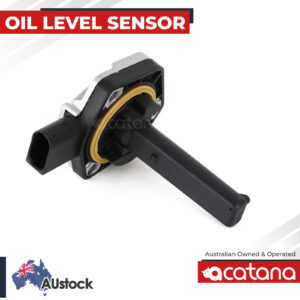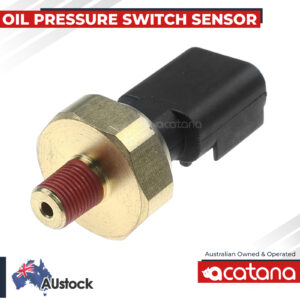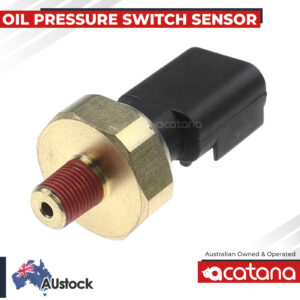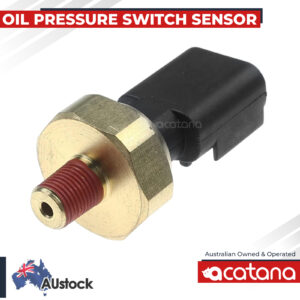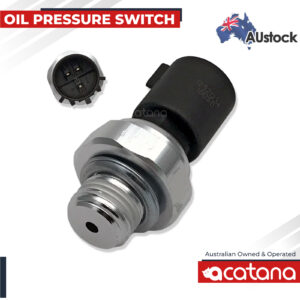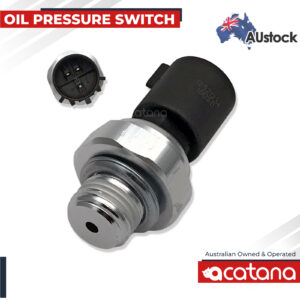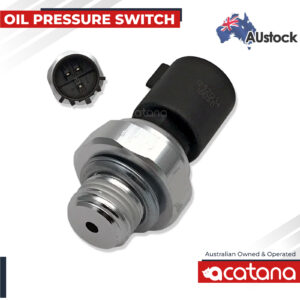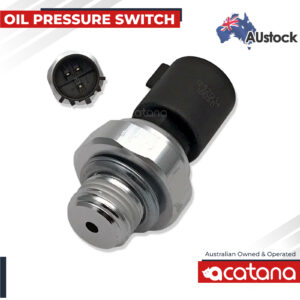Oil Pressure Switches
Shop by Filters
- Air Conditioning & Heating
- Car Care & Detailing
- Car Headlight Bulbs & Globes
- Car Keys & Remotes
- Drive Belt Parts
- Engine Cooling Components
- Find Car Parts by Make
- Fuel Delivery
- Fuel Pumps
- Ignition Systems & Components
- Interior & Body Parts
- New Arrivals Auto Parts
- Sensors
- ABS Wheel Speed Sensor
- Brake Light Switches
- Camshaft Position Sensors
- Crank Angle Position Sensors
- Diff Solenoid Valves
- Freewheel Actuators
- Idle Air Control Valves
- Knock Sensors
- MAF Mass Air Flow Meter Sensors
- MAP Manifold Absolute Pressure Sensors
- O2 Oxygen Sensors
- Oil Pressure Switches
- Sensors by Car Makes
- Suction Control Valve Sensors
- Timing Vacuum Sensors
- Vacuum Solenoid Valves
- Vanos Valvetronic Sensors
- Windscreen Washer Parts
Keep your engine running smoothly with our selection of high-quality oil pressure switches. These sensors are designed to monitor oil pressure and trigger a warning signal if pressure drops below a safe level.
Showing 1–24 of 31 results
-
SKU: 12617501786-BMWI
This Oil Level Sensor For BMW 116i 118i 120i 2003 – 2013 E81 E82 E87 E88 reliable replacement oil sensor – optimised performance, low fuel consumption and longer oil change intervalsto, fix the problem of engine start failure
$30.90$65.00 -
SKU: 12617501786-BMWX1
Oil Level Sensor For BMW X1 18i 2008 – 2014 N46 2.0L NA reliable replacement oil sensor – optimised performance, low fuel consumption and longer oil change intervalsto, fix the problem of engine start failure
$31.90$65.00 -
SKU: 12617501786-BMZ420I
Oil Level Sensor For BMW Z4 20i E85 2004 – 2008 N46 2.0L NA reliable replacement oil sensor – optimised performance, low fuel consumption and longer oil change intervalsto, fix the problem of engine start failure
$31.90$65.00 -
SKU: 05149062AA-JC
Oil Pressure Switch Sensor For Jeep Cherokee XJ 1999 – 2001 direct replacement for reliable protection engine device of your car. Easy installation and compatible with reference OEM 05149062AA, 05149064AA, 5149064AA, 56028807AA, 56028807AB
$23.90$39.00 -
SKU: 05149062AA-JCM
Oil Pressure Switch Sensor For Jeep Commander XH XK 2006 – 2010 direct replacement for reliable protection engine device of your car. Easy installation and compatible with reference OEM 05149062AA, 05149064AA, 5149064AA, 56028807AA, 56028807AB
$20.90$39.00 -
SKU: 05149062AA-JGC
Oil Pressure Switch Sensor For Jeep Grand Cherokee WH WK WJ WG direct replacement for reliable protection engine device of your car. Easy installation and compatible with reference OEM 05149062AA, 05149064AA, 5149064AA, 56028807AA, 56028807AB
$20.90$39.00 -
SKU: 05149062AA-JW
Oil Pressure Switch Sensor For Jeep Wrangler JK TJ 3.6L 3.8L 4.0L direct replacement for reliable protection engine device of your car. Easy installation and compatible with reference OEM 05149062AA, 05149064AA, 5149064AA, 56028807AA, 56028807AB
$20.90$39.00 -
SKU: 05149062AA-OE
Oil Pressure Switch Sensor direct replacement for reliable protection engine device of your car. Easy installation and compatible with reference OEM 05149062AA, 05149064AA, 5149064AA, 56028807AA, 56028807AB
$20.90$39.00 -
SKU: 12616646-Bui_Lac
This Oil Pressure Switch Sensor For Buick Lacrosse 2008 direct replacement for reliable protection engine device of your car. Easy installation and compatible with reference OEM 12616646, D1846A, PS308, 1S6713, S4202, 53-33660, 2078971144
$16.90$39.00 -
SKU: 12616646-Chev_Sil
Oil Pressure Switch Sensor For Chevrolet Silverado 1500 2003 – 2008 is a reliable protection device for an engine of your car. Also compatible with OEM 12616646, D1846A etc
$16.90$39.00 -
SKU: 12621234-HolGrange
This Oil Pressure Switch Sensor will seamlessly fit your HDT VC Retro VE 2008 – 2010 12621234 12673134
$20.50$49.00 -
SKU: 12621234-Hol_Cal
Oil Pressure Switch Sensor For Holden Calais VE 2010 – 2013 is a reliable protection device for an engine of your car. Also compatible with OEM 12621234, 12673134 etc
$20.50$49.00 -
SKU: 12621234-HolCrewman
Oil Pressure Switch Sensor For Holden Calais VF 2013 – 2015 is a reliable protection device for an engine of your car. Also compatible with OEM 12621234, 12673134 etc
$20.50$49.00 -
SKU: 12621234-Hol_L77
This Oil Pressure Switch Sensor will seamlessly fit your Holden Caprice WM 2010 – 2013 12621234 12673134
$20.50$49.00 -
SKU: 12621234-Caprice
This Oil Pressure Switch Sensor will seamlessly fit your For Holden Caprice WN 2013 – 2015 12621234 12673134
$20.50$49.00 -
SKU: 12616646-HCVE-A1
This Oil Pressure Switch Sensor For Holden Commodore VE 2006 – 2009 (V8, 6.0L) replacement for reliable protection engine device of your car. Easy installation and compatible with reference OEM 12616646, D1846A, PS308, 1S6713, S4202, 53-33660, 2078971144
$16.90$39.00 -
SKU: 12621234-HolGTS
Oil Pressure Switch Sensor For Holden Commodore VE 2009 – 2013 is a reliable protection device for an engine of your car. Also compatible with OEM 12621234, 12673134 etc
$20.50$49.00 -
SKU: 12621234-HolAvalanche
Oil Pressure Switch Sensor For Holden Commodore VF 2013 – 2015 is a reliable protection device for an engine of your car. Also compatible with OEM 12621234, 12673134 etc
$20.50$49.00 -
SKU: 12616646-Hol_Cal
Oil Pressure Switch Sensor For Holden Commodore VT 5.7L 1999 – 2000 is a reliable protection device for an engine of your car. Also compatible with OEM 12616646, D1846A
$16.90$39.00 -
SKU: 12616646
This Oil Pressure Switch Sensor for Holden Commodore VT VU VX VY VZ VE direct replacement for reliable protection engine device of your car. Easy installation and compatible with reference OEM 12573107, 12614969, 12616646
$17.90$39.00 -
SKU: 12616646-HCVUU
This Oil Pressure Switch Sensor For Holden Commodore VU Ute 5.7L 2001 – 2002 direct replacement for reliable protection engine device of your car. Easy installation and compatible with reference OEM 12616646, D1846A, PS308, 1S6713, S4202, 53-33660, 2078971144
$16.90$39.00 -
SKU: 12616646-HCVX
This Oil Pressure Switch Sensor For Holden Commodore VX 5.7L 2000 – 2002 direct replacement for reliable protection engine device of your car. Easy installation and compatible with reference OEM 12616646, D1846A, PS308, 1S6713, S4202, 53-33660, 2078971144
$16.90$39.00 -
SKU: 12616646-HCVY
This Oil Pressure Switch Sensor For Holden Commodore VY 5.7L 2002 – 2004 direct replacement for reliable protection engine device of your car. Easy installation and compatible with reference OEM 12616646, D1846A, PS308, 1S6713, S4202, 53-33660, 2078971144
$16.90$39.00 -
SKU: 12616646-Hol_Mon
This Oil Pressure Switch Sensor For Holden Monaro VE 2002 – 2007 direct replacement for reliable protection engine device of your car. Easy installation and compatible with reference OEM 12616646, D1846A, PS308, 1S6713, S4202, 53-33660, 2078971144
$16.90$39.00
ABOUT Oil Pressure Switch Sensor
What is oil pressure switch sensor?
An oil pressure switch sensor, also known as an oil pressure sensor or oil pressure sender, is a small electronic device that monitors the oil pressure in a vehicle's engine. It is typically located near the oil filter or on the engine block.
The oil pressure switch sensor works by detecting the pressure of the oil in the engine and sending a signal to the engine control module (ECM) or oil pressure gauge. If the oil pressure drops below a certain level, the oil pressure switch sensor will trigger an alert, such as a warning light on the dashboard or an audible alarm, to let the driver know that there is a problem with the oil pressure.
Low oil pressure can cause damage to the engine or result in engine failure, making it essential to detect and address any issues with the oil pressure as quickly as possible. By monitoring the oil pressure and alerting the driver to any problems, the oil pressure switch sensor helps to prevent costly engine repairs and ensures that the vehicle remains in good working order.
Oil pressure switch sensors are critical components of a vehicle's engine lubrication system and should be checked regularly as part of routine vehicle maintenance. If you suspect that your oil pressure switch sensor may be faulty, it is important to have it checked and replaced by a qualified mechanic.”
Oil pressure switch symptoms
“The oil pressure switch is a critical component of your vehicle's engine lubrication system, responsible for monitoring oil pressure and triggering a warning signal if pressure drops below a safe level. Here are some common symptoms of a failing oil pressure switch:
- Warning light: One of the most common symptoms of a faulty oil pressure switch is the illumination of the oil pressure warning light on the dashboard. This warning light typically looks like an oil can or an oil pressure gauge, and it will come on if the oil pressure drops below a certain level.
- Low oil pressure: If the oil pressure switch is failing or has failed, you may notice a drop in oil pressure on the gauge or a low reading on the oil pressure sensor. This can indicate that there is a problem with the oil pressure switch or the engine lubrication system.
- Engine damage: If the oil pressure switch fails to detect low oil pressure, it can cause engine damage or even engine failure. Signs of engine damage may include strange noises, loss of power, or difficulty starting the engine.
- Oil leaks: A faulty oil pressure switch can cause oil leaks around the switch or oil filter area. This can be caused by a damaged or worn gasket, which can allow oil to escape from the switch.
If you notice any of these symptoms, it is important to have your oil pressure switch checked and replaced by a qualified mechanic as soon as possible. Ignoring the warning signs can lead to serious engine damage or failure, which can be costly to repair”
Oil pressure switch location
The location of the oil pressure switch can vary depending on the make and model of your vehicle. However, here are some common locations where you may find the oil pressure switch:
- Near the oil filter: The oil pressure switch is often located close to the oil filter. It may be mounted on the engine block, oil filter adapter, or oil cooler lines.
- On the engine block: In some vehicles, the oil pressure switch is mounted directly on the engine block. You may need to look around the cylinder head or near the oil pump to find it.
- In the oil pressure gauge: Some vehicles have an oil pressure gauge that includes the oil pressure switch. In this case, the switch is usually located on the back of the gauge or in the instrument cluster.
- Under the dashboard: In rare cases, the oil pressure switch may be located under the dashboard. This is typically only seen in older vehicles.
If you are having trouble locating the oil pressure switch, refer to your vehicle's owner's manual or consult with a qualified mechanic. They will be able to help you locate the switch and identify any potential issues that need to be addressed.
How to replace oil pressure switch
Replacing the oil pressure switch is a relatively simple process that can be completed in a few steps:
- Locate the oil pressure switch: Before you begin, you will need to locate the oil pressure switch. Refer to your vehicle's owner's manual or consult with a qualified mechanic if you need help locating it.
- Disconnect the battery: To avoid any electrical hazards, disconnect the battery before you begin working on the oil pressure switch.
- Remove the old oil pressure switch: Use a wrench or socket to remove the old oil pressure switch. Be sure to have a container ready to catch any oil that may leak out.
- Replace the old oil pressure switch: Install the new oil pressure switch in place of the old one. Be sure to use a new gasket or seal to prevent oil leaks.
- Reconnect the battery: Once you have installed the new oil pressure switch, reconnect the battery and test the new switch to ensure that it is working properly.
- Check for oil leaks: Start the engine and check for any oil leaks around the oil pressure switch. If you notice any leaks, tighten the switch or gasket as needed.
It is important to note that the exact process for replacing the oil pressure switch may vary depending on the make and model of your vehicle. Always refer to your vehicle's owner's manual or consult with a qualified mechanic if you are unsure about the replacement process.
Showing 1–24 of 31 results

